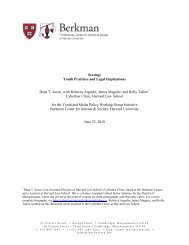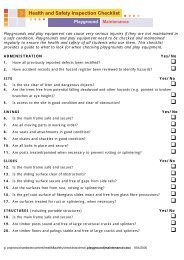Download PDF - Fair Play For Children
Download PDF - Fair Play For Children
Download PDF - Fair Play For Children
You also want an ePaper? Increase the reach of your titles
YUMPU automatically turns print PDFs into web optimized ePapers that Google loves.
<strong>Children</strong>’s <strong>Play</strong> initiative to support development of free, local, inclusive play spaces, with the<br />
remaining funds being used to support play infrastructure and local projects.<br />
10.<br />
11.<br />
12.<br />
The <strong>Children</strong>’s Plan announced a significant programme of capital investment to make more<br />
play areas safe and exciting places to be. We are making our biggest ever investment of £235<br />
million in play over the three years 2008–11. Exciting new public play areas will be developed<br />
with this investment, led strategically by local authorities working in partnership with district<br />
and town councils, the third sector, children, families and community groups. In April 2008, 63<br />
local authorities will begin using their funding to improve local play offers, including 20 large<br />
scale pathfinder authorities 2 .<br />
<strong>Play</strong> space needs to be of high quality and good design to attract children and families and<br />
become a valued part of the local environment. Poor quality, unimaginative space will not be<br />
attractive to children, will not be valued by the local community, and will fall into disuse and<br />
disrepair. Good design is a good investment.<br />
In order to create more high quality places to play, we propose to:<br />
a. invest £235 million over the next three years to develop up to 3,500 public play areas;<br />
b. support pathfinders to develop 30 adventure playgrounds or play parks aimed at<br />
8–13 year-olds in disadvantaged areas;<br />
c.<br />
work with local authorities to ensure sites are stimulating, exciting, and attractive to<br />
children – including through closely involving children, families and communities in<br />
planning and design;<br />
d. provide clear guidance on developing interesting and fun places to play; and<br />
e. emphasise the importance of maintaining sites.<br />
<strong>Play</strong>ing safely<br />
13.<br />
14.<br />
15.<br />
<strong>Children</strong> need to take risks to learn how to manage risks. This is an essential part of growing<br />
up, and play is one of the most important ways in which they develop this vital skill. Riding a<br />
bicycle, climbing a scramble net, or pushing a friend on a swing all involve risk. It is essential<br />
that we do not try and remove all the risk from play or wrap children in cotton wool.<br />
Concerns about safety are among the biggest barriers to outdoor play that children face, but<br />
this does not mean we should be stopping them from learning and exploring. The Government<br />
is committed to addressing these concerns and to tackling safety issues and perceptions that<br />
are preventing children from enjoying play.<br />
<strong>Children</strong> and young people today are, in many ways, safer than in previous generations. Eighty<br />
seven per cent of young people responding to the Staying Safe 3 consultation thought children<br />
were safe, and rates of accidents are down, including on the roads. Yet three-quarters of parents<br />
say they think children today are more at risk than children five years ago. i<br />
2 See Annex 1<br />
3 See www.everychildmatters.gov.uk/stayingsafe<br />
<strong>Fair</strong> <strong>Play</strong>: A consultation on the play strategy<br />
3





![The Childcare Act 2006 - Notes [Website] - Fair Play For Children](https://img.yumpu.com/50144819/1/184x260/the-childcare-act-2006-notes-website-fair-play-for-children.jpg?quality=85)




![Bouncy Castles [PDF] - Fair Play For Children](https://img.yumpu.com/45463572/1/184x260/bouncy-castles-pdf-fair-play-for-children.jpg?quality=85)






